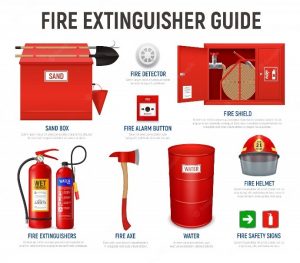Understanding Four Options of Fire Protection Systems

Image Source: Freepik
When it comes to fire protection systems, there are three primary options: manual detection, automatic detection, and a hybrid system that combines the benefits of both. Understanding these systems and their pros and cons will help you evaluate which is the best option for your business. All commercial buildings should have a fire protection system in place. Here’s more information about each of these three types of fire protection systems so you’ll be prepared when planning for fire safety in your business.
Fire Protection Systems – Manual Fire Sprinkler Systems
Manual fire sprinkler systems are the oldest type of fire sprinkler system. These systems use a series of valves and piping connected to sprinkler heads in various parts of the building. When a fire is detected, an employee must manually open the appropriate valve to release water through the sprinkler heads and put out the fire. This can take time, and during a fire, every second counts. Manual systems are also prone to human error, and in some cases, the valves can jam or break.
Fire Protection Systems – Automatic Fire Sprinkler Systems
Automatic fire sprinkler systems use sensors to detect when a fire breaks out and send a signal to open the valves and activate the sprinkler heads. They’re also easier to maintain and repair, since the system automatically shuts off the sprinklers once the fire is out. Automatic systems also offer a higher level of protection against false alarms, since they’re programmed to ignore things like steam or hot running machines.
Fire Protection Systems – Hybrid Fire Sprinkler System
A hybrid fire sprinkler system is a combination of the two systems above. It uses an automatic sensor as the primary fire detection method, but it also includes manual sprinklers in high-risk areas like the kitchen and near hazardous materials. You can also add manual sprinklers in areas that face a high risk of false alarms, such as areas near the dust from saws and other manufacturing equipment. Hybrid systems are also easier to maintain than automatic systems since they have some manual components. In the event of a power outage, the manual sprinklers will continue to work.
Fire Protection Systems – Fire Detection Using a Dry Pipe System
A dry pipe system is a fire protection system that uses a series of alarms to detect fire and a water tank to store water. It doesn’t have any sprinkler heads that release water when a fire is detected; instead, it uses a pressurized system of water. A dry pipe system usually has a series of alarms that sound when a fire is detected. This system is used in areas that don’t face a high risk of fire, like office buildings and warehouses. Dry pipe systems are less expensive than other types of sprinkler systems, but they’re also less reliable and don’t provide the same level of protection.
Conclusion
Fire protection systems are an essential part of any commercial building. They can help prevent fires from starting in the first place and keep them from spreading. Ideally, you’ll have a fire protection system installed before any fires break out. However, if you don’t have a system in place, you can retrofit your building to add fire protection. When choosing the type of fire protection system for your building, keep in mind what level of risk your building faces and how much you’re able to spend.
For more information on Safety Training do click this link to MASMA Safety or click here for more information. Do not hesitate to call us at 019-2000643. MASMA Fire Engineering – Your Trusted Fire Contractor.
